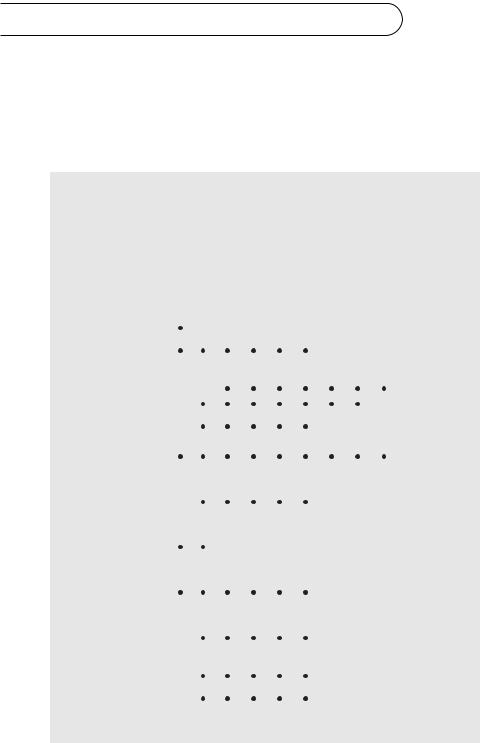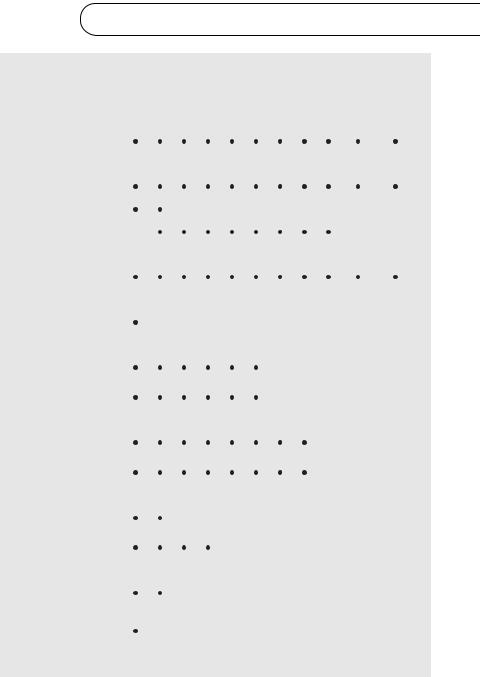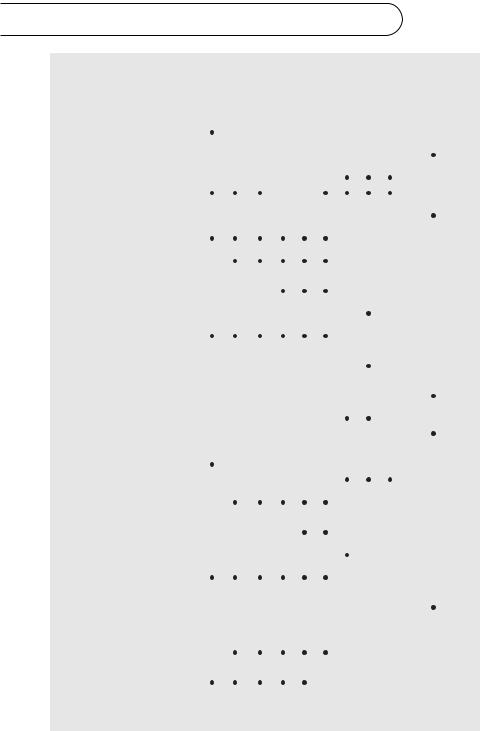
- •Contents
- •Series Preface
- •Acknowledgments
- •Purposes and Uses of Achievement Tests
- •Diagnosing Achievement
- •Identifying Processes
- •Analyzing Errors
- •Making Placement Decisions and Planning Programs
- •Measuring Academic Progress
- •Evaluating Interventions or Programs
- •Conducting Research
- •Screening
- •Selecting an Achievement Test
- •Administering Standardized Achievement Tests
- •Testing Environment
- •Establishing Rapport
- •History and Development
- •Changes From KTEA-II to KTEA-3
- •Subtests
- •Mapping KTEA-3 to Common Core State Standards
- •Standardization and Psychometric Properties of the KTEA-3
- •Standardization
- •Reliability
- •Validity
- •Overview of the KTEA-3 Brief Form
- •Brief Form Standardization and Technical Characteristics
- •How to Administer the KTEA-3
- •Starting and Discontinuing Subtests
- •Sample, Teaching, and Practice Items
- •Recording Responses
- •Timing
- •Queries and Prompts
- •Subtest-by-Subtest Notes on Administration
- •How to Score the KTEA-3
- •Types of Scores
- •Subtest-by-Subtest Scoring Keys
- •How to Interpret the KTEA-3
- •Introduction to Interpretation
- •Step 1: Interpret the Academic Skills Battery (ASB) Composite
- •Step 2: Interpret Other Composite Scores and Subtest Scores
- •Subtest Floors and Ceilings
- •Interpretation of Composites
- •Clinical Analysis of Errors
- •Qualitative Observations
- •Using the KTEA-3 Across Multiple Administrations
- •Repeated Administrations of the Same Form
- •Administering Alternate Forms
- •Using the KTEA-3 Brief Form
- •Progress Monitoring
- •Screening for a Comprehensive Evaluation
- •KTEA-3 Score Reports
- •History and Development
- •Changes From WIAT-II to WIAT-III
- •Age Range
- •New and Modified Subtests
- •Composites
- •Administration and Scoring Rules
- •Skills Analysis
- •Intervention Goal Statements
- •New Analyses
- •New Scores
- •Validity Studies
- •Materials
- •Scoring and Reporting
- •Description of the WIAT-III
- •Subtests With Component Scores
- •Mapping WIAT-III to Common Core State Standards
- •Standardization and Psychometric Properties of the WIAT-III
- •Standardization
- •Reliability
- •Validity
- •Starting and Discontinuing Subtests
- •Sample, Teaching, and Practice Items
- •Recording Responses
- •Timing
- •Queries and Prompts
- •Subtest-by-Subtest Notes on Administration
- •How to Score the WIAT-III
- •Types of Scores
- •Score Reports
- •Subtest-by-Subtest Scoring Keys
- •Listening Comprehension
- •Early Reading Skills
- •Reading Comprehension
- •Sentence Composition
- •Word Reading and Pseudoword Decoding
- •Essay Composition
- •Numerical Operations
- •Oral Expression
- •Oral Reading Fluency
- •Spelling
- •Math Fluency—Addition, Subtraction, and Multiplication
- •Introduction to Interpretation
- •Step 1: Interpret the Composite Scores
- •Subtest Floors and Ceilings
- •Skills Analysis
- •Intervention Goal Statements
- •Qualitative Data
- •Using the WIAT-III Across Multiple Administrations
- •Linking Studies
- •Overview of the WISC-V, WISC-V Integrated, and KABC-II
- •Qualitative/Behavioral Analyses of Assessment Results
- •Identification of Specific Learning Disabilities
- •Interpretation and Use of Three New Composite Scores
- •Accommodations for Visual, Hearing, and Motor Impairments
- •Ongoing Research on Gender Differences in Writing and the Utility of Error Analysis
- •Female Advantage in Writing on KTEA-II Brief and Comprehensive Forms
- •Strengths and Weaknesses of the KTEA-3
- •Assets of the KTEA-3
- •Test Development
- •Two Forms
- •Standardization
- •Reliability and Validity
- •Administration and Scoring
- •Interpretation
- •Phonological Processing
- •KTEA-3 Flash Drive
- •Limitations of the KTEA-3
- •Test Development
- •Standardization
- •Reliability and Validity
- •Administration and Scoring
- •Test Items
- •Interpretation
- •Final Comment
- •Strengths and Weaknesses of the WIAT-III
- •Assets of the WIAT-III
- •Test Development
- •Normative Sample
- •Reliability and Validity
- •Administration and Scoring
- •Interpretation
- •Better Listening Comprehension Measure
- •Technical Manual
- •Limitations of the WIAT-III
- •Floor and Ceiling
- •Test Coverage
- •Poor Instructions for Scoring Certain Tasks
- •Item Scoring
- •Audio Recorder
- •Final Comment
- •Content Coverage of the KTEA-3 and WIAT-III
- •Case Report 1: Jenna
- •Reason for Evaluation
- •Background Information
- •Behavioral Observations
- •Assessment Procedures and Tests Administered
- •Test Results
- •Neuropsychological Implications and Diagnostic Impressions
- •Recommendations
- •Psychometric Summary for Jenna
- •Case Report 2: Oscar
- •Reason for Evaluation
- •Background Information
- •Behavioral Observations
- •Assessment Procedures and Tests Administered
- •Test Results
- •Diagnostic Summary
- •Recommendations
- •Resources
- •Psychometric Summary for Oscar
- •Case Report 3: Rob
- •Purpose of the Evaluation
- •History and Background
- •Behavioral Observations
- •Assessment Procedures and Tests Administered
- •Results
- •Summary and Diagnostic Impressions
- •Recommendations
- •Psychometric Summary for Rob
- •Q-interactive Versus Q-global
- •Equivalency Studies
- •Essential Features of Q-interactive
- •Key Terminology
- •Central Website
- •Assess Application
- •References
- •Annotated Bibliography
- •About the Authors
- •About the Digital Resources
- •Index

KTEA™-3 25
through 12 and above. Rapid Reference 2.4 lists which subtests contribute to the Supplemental composites.

 Rapid Reference 2.4
Rapid Reference 2.4
.....................................................................................................................
Structure of the KTEA-3 Supplemental Composites
Reading Related |
|
|
|
|
Composites |
Grade |
Subtests Administered |
|
|
|
|
|
|
|
Sound-Symbol |
1–12+ |
Phonological |
Nonsense Word |
|
|
1–12+ |
Processing |
Decoding |
|
Decoding |
Letter & Word |
Nonsense Word |
|
|
|
3–12+ |
Recognition |
Decoding |
|
Reading Fluency |
Silent Reading |
Word Recognition |
Decoding |
|
|
1–12+ |
Fluency |
Fluency |
Fluency |
Reading Under- |
Reading |
Reading Vocabulary |
|
|
standing |
|
Comprehension |
|
|
|
|
|
|
|
Oral Composites |
|
|
|
|
|
|
|
|
|
Oral Language |
PK–12+ Associational 111111111 |
Listening |
Oral |
|
|
|
22222222 |
Comprehension |
Expression |
|
|
Fluency |
||
Oral Fluency |
PK–12+ Associational |
Object Naming |
|
|
|
|
Fluency |
Fluency |
|
|
|
|
|
|
Cross-Domain Composites |
|
|
|
|
|
|
|
|
|
Comprehension |
PK–12+ Reading |
Listening |
|
|
|
|
Comprehension |
Comprehension |
|
Expression |
PK–12+ Written Expression |
Oral Expression |
|
|
Orthographic |
1–12+ |
Spelling |
Letter Naming |
Word |
Processing |
|
|
Facility |
Recognition |
|
3–12+ |
|
|
Fluency |
Academic |
Writing Fluency |
Math Fluency |
Decoding |
|
Fluency |
|
|
|
Fluency |
|
|
|
|
|
Mapping KTEA-3 to Common Core State Standards
The KTEA-3 was not designed as a measure of Common Core State Standards (CCSS; National Governors Association Center for Best Practices & Council of Chief State School O cers, 2010). Rather, the KTEA-3 is intended for use in all 50 states, regardless of whether a state has adopted CCSS.
For practitioners interested in mapping the KTEA-3 to CCSS, the tables in Rapid Reference 2.5 show that the KTEA-3 measures many of the skills identified by the

26 ESSENTIALS OF KTEA™-3 AND WIAT®-III ASSESSMENT
Common Core State Standards (CCSS) as important for meeting grade level expectations. As explained in the Technical & Interpretive Manual (Kaufman & Kaufman, 2014b, p. 136), the KTEA-3 was designed to measure skills that are both clinically sensitive and correspond to CCSS whenever possible. However, certain CCSS are not measured by the KTEA-3 because the standards are not relevant to the purpose and intended use of the KTEA-3, or the skill would be di cult to measure with a norm-referenced clinical assessment (Kaufman & Kaufman, 2014b, pp. 136–137).

 Rapid Reference 2.5
Rapid Reference 2.5
.....................................................................................................................
KTEA-3 and the Common Core State Standards
KTEA-3 Content Map to English Language Arts CCSS
Subtest |
|
|
|
|
|
Grade |
|
|
|||
CCSS Domain |
K |
1 |
2 |
3 |
4 |
5 |
6 |
7 |
8 |
9–10 |
11–12 |
Letter & Word Reco |
gnitio |
n |
|
|
|
|
|
|
|
|
|
Print Concepts |
|
— |
|
|
|
|
|
|
|
|
|
Phonics and Word |
|
|
|
|
|
|
|
|
|
|
|
Recognition |
|
|
|
|
|
|
|
|
|
|
|
Reading Comprehension |
111111111 |
|
|
|
|
|
|
|
|||
|
|
22222222 |
|
|
|
|
|
|
|||
Craft and Structure |
— |
— |
|
|
|
|
|
|
|
— |
— |
Key Ideas and Details |
— |
|
|
|
|
|
|
|
— |
— |
— |
|
|
|
|
|
|
|
|
|
|
|
|
Phonics and Word |
— |
|
|
|
|
|
|
|
|
|
|
Recognition |
|
|
|
|
|
|
|
|
|
|
|
|
|
|
|
|
|
|
|
|
|
|
|
Vocabulary |
|
|
|
|
|
|
|
|
|
— |
— |
Acquisition and Use |
|
|
|
|
|
|
|
|
|
||
|
|
|
|
|
|
|
|
|
|
|
|
Nonsense Word Decoding |
|
|
|
|
|
|
|
|
|
|
|
Phonics and Word |
— |
|
|
|
|
|
|
|
|
|
|
Recognition |
|
|
|
|
|
|
|
|
|
|
|
|
|
|
|
|
|
|
|
|
|
|
|
Phonological Processing |
|
|
|
|
|
|
|
|
|
|
|
Phonological |
|
|
|
|
|
|
|
|
|
|
|
Awareness |
|
|
|
|
|
|
|
|
|
|
|
Word Recognition Fluency |
|
|
|
|
|
|
|
|
|
|
|
Phonics and Word |
|
|
|
|
|
|
|
|
|
|
|
Recognition |
|
|
|
|
|
|
|
|
|
|
|
Decoding Fluency |
|
|
|
|
|
|
|
|
|
|
|
Phonics and Word |
— |
|
|
|
|
|
|
|
|
|
|
Recognition |
|
|
|
|
|
|
|
|
|
|
|
|
|
|
|
|
|
|
|
|
|
|
|
Silent Reading Fluency |
|
|
|
|
|
|
|
|
|
|
|
Fluency |
— |
|
|
|
|
|
|
|
|
|
|
Phonics and Word |
— |
|
|
|
|
|
|
|
|
|
|
Recognition |
|
|
|
|
|
|
|
|
|
|
|
|
|
|
|
|
|
|
|
|
|
|
|
|
|
|
|
|
|
|
|
|
|
(continued) |
|

KTEA™-3 27
(Continued)
Subtest |
|
|
|
|
|
Grade |
|
|
|||
CCSS Domain |
K |
1 |
2 |
3 |
4 |
5 |
6 |
7 |
8 |
9–10 |
11–12 |
Reading Vocabulary |
|
|
|
|
|
|
|
|
|
|
|
Vocabulary |
|
|
|
|
|
|
|
|
|
|
|
Acquisition and Use |
|
|
|
|
|
|
|
|
|
|
|
Written Expression |
|
|
|
|
|
|
|
|
|
|
|
Conventions of |
|
|
|
|
|
|
|
|
|
|
|
Standard English |
|
|
|
|
|
|
|
|
|
|
|
|
|
|
|
|
|
|
|
|
|
|
|
Print Concepts |
|
|
|
|
|
|
|
|
|
|
|
Text Types and |
— |
|
|
|
|
|
|
|
|
— |
— |
Purposes |
|
|
|
|
|
|
|
|
|||
|
|
|
|
|
|
|
|
|
|
|
|
Spelling |
|
|
|
|
|
|
|
|
|
|
|
Conventions of |
|
|
|
|
|
|
|
|
|
|
|
Standard English |
|
|
|
|
|
|
|
|
|
|
|
Writing Fluency |
|
|
|
|
|
|
|
|
|
|
|
Text Types and |
|
— |
— |
— |
— |
— |
— |
— |
— |
— |
— |
Purposes |
|
||||||||||
|
|
|
|
|
|
|
|
|
|
|
|
Listening Comprehension |
|
|
|
|
|
|
|
|
|
|
|
Comprehension and |
|
|
|
|
|
|
— |
— |
— |
— |
— |
Collaboration |
|
|
|
|
|
|
|||||
|
|
|
22222222111111111 |
|
|
|
|
|
|
|
|
Vocabulary |
|
|
|
|
|
|
— |
— |
— |
— |
— |
Acquisition and Use |
|
|
|
|
|
|
|||||
|
|
|
|
|
|
|
|
|
|
|
|
Oral Expression |
|
|
|
|
|
|
|
|
|
|
|
Conventions of |
|
|
|
|
|
|
|
|
— |
— |
— |
Standard English |
|
|
|
|
|
|
|
|
|||
|
|
|
|
|
|
|
|
|
|
|
|
|
|
|
|
|
|
|
|
|
|
|
|
Presentation of |
|
|
|
|
|
|
|
|
— |
— |
— |
Knowledge and Ideas |
|
|
|
|
|
|
|
|
|||
|
|
|
|
|
|
|
|
|
|
|
|
Associational Fluency |
|
|
|
|
|
|
|
|
|
|
|
Presentation of |
|
|
— |
— |
— |
— |
— |
— |
— |
— |
— |
Knowledge and Ideas |
|
|
|||||||||
|
|
|
|
|
|
|
|
|
|
|
|
|
|
|
|
|
|
|
|
|
|
|
|
Vocabulary |
|
|
|
|
— |
— |
— |
— |
— |
— |
— |
Acquisition and Use |
|
|
|
|
|||||||
|
|
|
|
|
|
|
|
|
|
|
|
Object Naming Facility |
|
|
|
|
|
|
|
|
|
|
|
Presentation of |
|
|
— |
— |
— |
— |
— |
— |
— |
— |
— |
Knowledge and Ideas |
|
|
|||||||||
|
|
|
|
|
|
|
|
|
|
|
|
Letter Naming Facility |
|
|
|
|
|
|
|
|
|
|
|
Print Concepts |
|
— |
|
|
|
|
|
|
|
|
|
Note: If a cell is shaded, no Common Core State Standard is available for that domain at that grade level.

28 ESSENTIALS OF KTEA™-3 AND WIAT®-III ASSESSMENT
KTEA-3 Content Map to Mathematics CCSS
Subtest |
|
|
|
|
|
Grade |
|
|
||
CCSS Domain |
K |
1 |
2 |
3 |
4 |
5 |
6 |
7 |
8 |
High School |
Math Concepts & Applicatio |
ns |
|
|
|
|
|
|
|
|
|
Counting and Cardinality |
|
|
|
|
|
|
|
|
|
|
Conditional Probability and |
|
|
|
|
|
|
|
|
|
|
the Rules of Probability |
|
|
|
|
|
|
|
|
|
|
Expressions and Equations |
|
|
|
|
|
|
|
|
|
|
Geometry |
|
|
|
— |
— |
|
|
|
|
|
Linear, Quadratic, and |
|
|
|
|
|
|
|
|
|
|
Exponential Models |
|
|
|
|
|
|
|
|
|
|
Measurement and Data |
|
|
|
|
|
|
|
|
|
|
Number and Operations |
— |
|
|
|
|
|
|
|
|
|
in Base Ten |
|
|
|
|
|
|
|
|
|
|
|
|
|
|
|
|
|
|
|
|
|
Number and Operations— |
|
|
|
|
|
|
|
|
|
|
Fractions |
|
|
|
|
|
|
|
|
|
|
The Number System |
|
|
|
|
|
|
— |
|
— |
|
Operations and Algebraic |
|
|
|
|
|
|
|
|
|
|
Thinking |
|
|
|
|
|
|
|
|
|
|
Ratios and Proportional |
|
|
|
|
|
|
— |
|
|
|
Relationships |
|
|
|
|
|
|
|
|
|
|
|
|
111111111 |
|
|
|
|
|
|
|
|
|
|
|
22222222 |
|
|
|
|
|
|
|
Similarity, Right Triangles, |
|
|
|
|
|
|
|
|
|
|
and Trigonometry |
|
|
|
|
|
|
|
|
|
|
Statistics and Probability |
|
|
|
|
|
|
|
|
— |
|
Trigonometric Functions |
|
|
|
|
|
|
|
|
|
|
Math Computation |
|
|
|
|
|
|
|
|
|
|
Counting and Cardinality |
|
|
|
|
|
|
|
|
|
|
Expressions and Equations |
|
|
|
|
|
|
|
|
|
|
Number & Operations |
— |
|
|
|
|
|
|
|
|
|
in Base Ten |
|
|
|
|
|
|
|
|
|
|
|
|
|
|
|
|
|
|
|
|
|
Number & Operations— |
|
|
|
— |
|
|
|
|
|
|
Fractions |
|
|
|
|
|
|
|
|
|
|
|
|
|
|
|
|
|
|
|
|
|
The Number System |
|
|
|
|
|
|
|
— |
— |
|
Operations and Algebraic |
|
|
|
|
|
|
|
|
|
|
Thinking |
|
|
|
|
|
|
|
|
|
|
Seeing Structure in |
|
|
|
|
|
|
|
|
|
|
Expressions |
|
|
|
|
|
|
|
|
|
|
Math Fluency |
|
|
|
|
|
|
|
|
|
|
Number & Operations |
— |
|
|
|
|
|
|
|
|
|
in Base Ten |
|
|
|
|
|
|
|
|
|
|
|
|
|
|
|
|
|
|
|
|
|
Operations and Algebraic |
|
|
|
|
|
— |
|
|
|
|
Thinking |
|
|
|
|
|
|
|
|
|
|
|
|
|
|
|
|
|
|
|
|
|
Note: If a cell is shaded, no Common Core State Standard is available for that domain at that grade level.
